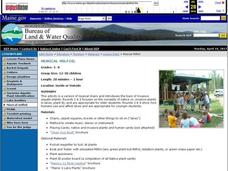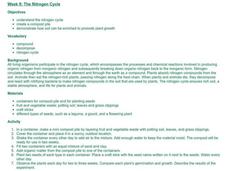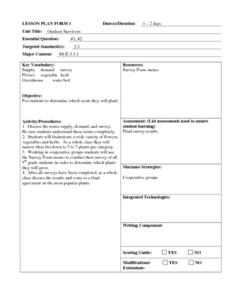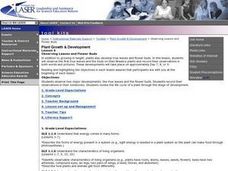Curated OER
Mold
Students explore mold, the different types and the health risks that they pose. In this mycelium lesson students grow different molds and see which type of foods mold the fastest.
Alabama Learning Exchange
Why Roots, Stems, and Leaves are Important
Young scholars use the Internet to research the importance of leaves, stems and roots to plants. They participate in a hands-on experiment to identify the functions of different plant parts.
Curated OER
Survival of the Spiniest
In this earth science learning exercise, students identify and discover the amazing ways that desert plants adapt to harsh habitats. They use discussion and drawing to explore their existing knowledge about deserts. Then, students...
Curated OER
Container Gardening: A Rainbow Garden
In this container gardening a rainbow garden worksheet, students look in a catalog or garden center to find flowers in every color of the rainbow, then list the names of the plants.
Curated OER
Seed Structure and Seed Dispersal
Third graders plant seeds. In this seed structure lesson, 3rd graders identify parts of a seed and plant a lima bean seed. Students discuss and reflect on the process in their journals.
Curated OER
Defining Drought
Students examine the hydrologic impacts of drought. They look at drought from a variety of prespectives. Students first focus on the scientific definition of drought, including weather patterns, water cycles, water requirements by plants...
Curated OER
Musical Milfoil
Young scholars play a game that is a version of musical chairs to introduce them to invasive aquatic plants. In this aquatic plants lesson plan, students play 4 rounds of this game.
Curated OER
Cotton Seed Planting
Students using scientific inquiry will observe and record in daily journals their findings on cotton seeds. They measure, graph, and then communicate their discoveries about plants to each other.
Curated OER
Composting
Students discover the concept of decomposition. They examine how it makes the soil more fertile and how it helps plants. They put a compost bin in their backyard and record their observations.
Curated OER
The Nitrogen Cycle
Students design and create a compost pile in order to study the Nitrogen Cycle. They then use the scientific method to determine if plants grow better when they add organic matter from their compost pile to the plant's soil.
Curated OER
Getting a Handle on Your Bee
Students observe dried bees, carefully glue them to toothpicks, and use them for cross pollinating their Brassica plants. They also describe reasons why two similar investigations can produce different results. Finally, students...
Curated OER
Making Pretzels
Students discover that plants provide food products to humans. In this baking lesson, students grind wheat seeds into flour and then use the flour to make pretzels. Students participate in a variety of activities that involve them in...
Curated OER
How Can You Test Your Soil?
Learners investigate chemicals in soil samples. In this soil science lesson, students test local soil to measure the pH, nitrate, phosphate, and potassium content.
Curated OER
Shine On, Moon
Students explore space science by conducting an experiment in class. In this Moon lesson, students define a list of space science vocabulary and read the book The Moon. Students utilize shoeboxes and string to conduct a sunlight...
Curated OER
Outdoor Survivors
Fifth graders complete a survey to decide what are most popular plants among the class. They test the water quality in a nearby pond. Studnts test the quality of soil samples taken from their homes. Different plants are moistened with...
Curated OER
Dna in the Garden - Where It All Began
In this DNA instructional activity, learners read about Gregor Mendel and his experiments with plants and DNA. Students complete a crossword puzzle using 10 vocabulary words from the selection.
Curated OER
Pop Bottle Terrarium
Students make terrariums out of bottles, pebbles, cuttings from other plants, and water. In this terrarium lesson plan, students learn about recycling by using household items to make terrariums.
Curated OER
Ecosystems and Climate
Students examine climatic effects on ecosystems. They plant tomatoes and observe the differences in plant growth with differences in light. They create picture collages of plants, animals, and insects found in each climate of the U.S.
Curated OER
Observing Leaves and Flower Buds
Students observe the first true leaves and the buds on their Brassica plants and record their observations in both words and pictures. They also observe two major developments: the true leaves and the flower buds and record their...
Curated OER
Hold on Tight!
Students explore the close connection between plant roots and the soil in which they grow. They investigate the roots of plants, make models of plant roots using pipe cleaners, and examine photos and images to explore the connection...
Curated OER
Bikini Bottom Experiments
In this science worksheet, students read the description for each experiment and use their knowledge of the scientific method to respond to each of the questions. Then they write an experiment to test bubble power of the bubble gum...
Curated OER
Our Healthy Bodies
Students complete a variety of activities designed to enhance their awareness of their bodies. They examine pictures of themselves, taken at various points in the year and examine and compare their bodies. They enjoy a healthy snack...
Curated OER
Plankton
Students research phytoplankton and zooplankton. In this food chain lesson, students read This is the Sea That Feeds Us and discuss plankton, food chains, and webs. Students define phytoplankton and compare them to land plants. Students...
Curated OER
George Washington Carver
Students write three contributions made to society by George Washington Carver. They complete a handout listing the four things plants need to grow.

























